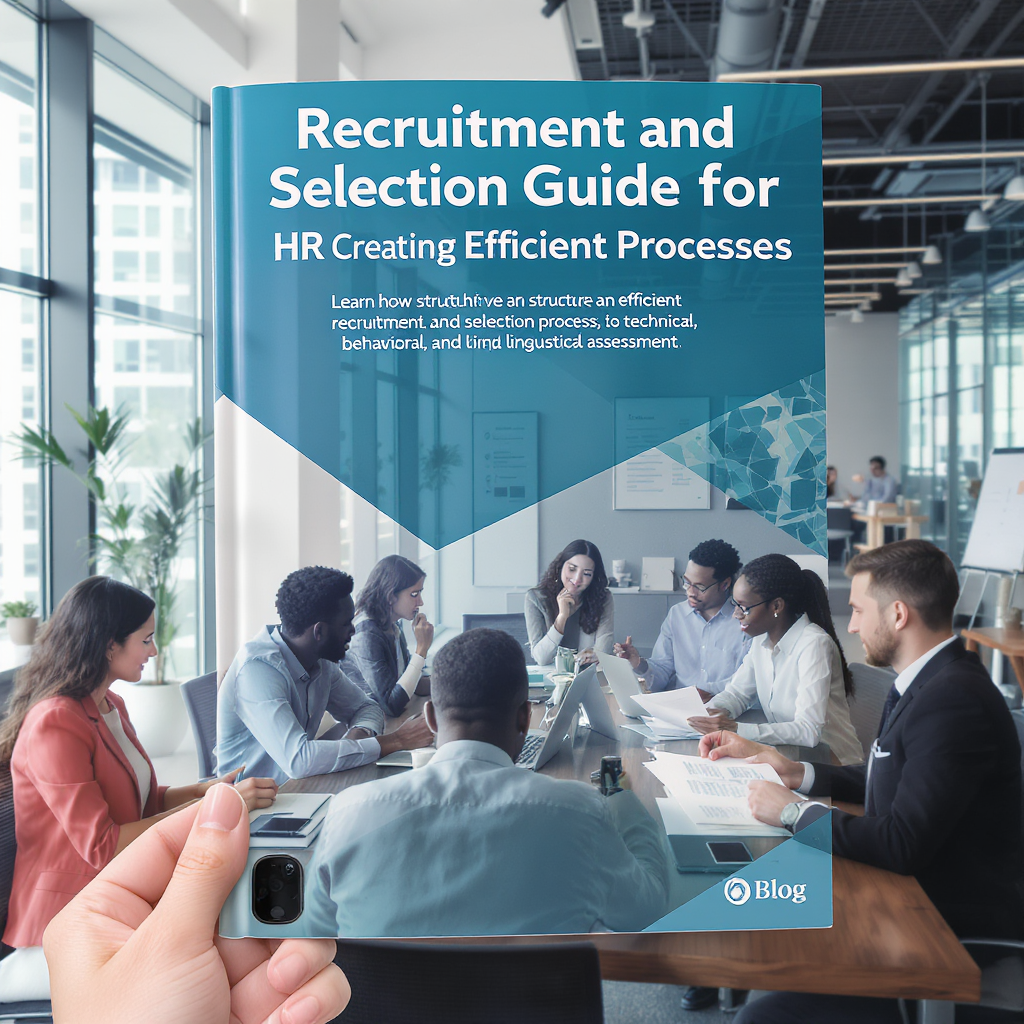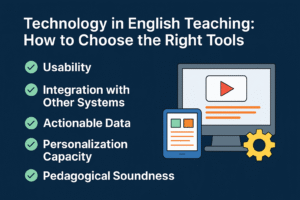Learn how to structure an efficient recruitment and selection process, focusing on technical, behavioural and linguistic assessment.
In today’s corporate landscape, dominated by agility and global competitiveness, HR professionals face the challenge of attracting and retaining talent assertively.
A well-planned recruitment and selection process not only improves the quality of hires but also has a direct impact on the company’s culture, economy and performance.
Among the many skills assessed, fluency in English has become essential in roles with international relations. This knowledge equips HR professionals with the awareness they need to make informed hiring decisions.
In this guide, you’ll find effective practices, from profile definition to onboarding, designed to make the entire process more coherent, inclusive, and prepared for the demands of the modern corporate world. These insights will keep you engaged and motivated to improve your recruitment and selection processes.
Check out the topics we’ll cover in this article:
- Why Invest in Structured Recruitment and Selection?
- How to define a clear and aligned job profile
- How to screen CVs intelligently
- Main stages of an effective process
- How to conduct technical assessments effectively
- In-depth behavioural assessment
- English fluency assessment: it goes far beyond the CV
- Digital tools that speed up every stage
- Best practices and final recommendations
- Conclusion
Why Invest in Structured Recruitment and Selection?
Imagine a link in the organizational chain failing: the inadequate hiring of a professional causes internal and external impacts. A structured process avoids this.
Firstly, it reduces the risks of turnover and rework. SHRM research indicates that organized processes can reduce hiring time by up to 20% while increasing the quality of new hires by up to 30%.
In addition, the way candidates are treated from the outset reinforces Employer Branding; companies that offer transparent processes gain respect and attract better talent.
Ultimately, a fair process fosters an inclusive culture by eliminating unconscious biases and promoting transparency.
How to define a clear and aligned job profile
The starting point is to be clear about what the company needs.
This involves mapping out technical competencies (hard skills), such as mastery of tools, methodologies, or frameworks, and behavioural competencies (soft skills), including communication, collaboration, and resilience.
When the vacancy requires English, defining whether the need is only for reading or whether there is involvement with negotiations and presentations is crucial, as this refines the choice between proficiency and fluency.
Finally, understanding the cultural profile of the company and the team ensures faster and more sustainable integration. This briefing with managers is the foundation that defines each subsequent stage.
How to screen CVs intelligently
CV screening must incorporate objective criteria. The focus should be on the relevance of the experience to the position, the coherence of the professional career and the consistency between self-declarations and the expectations of the position.
When fluency in English is essential, making it clear in the notice that a language test will be administered directly addresses concerns and avoids surprises.
Blind hiring, which removes names and photos from CVs, is a good practice for organizations committed to eliminating unconscious bias in the pre-selection process.
Main stages of an effective process
An efficient process goes through several logical and progressive phases:
- Detailed briefing with internal managers: combines an understanding of the profile with the scope of the deliverables;
- Objective screening of CVs: applying clear criteria to filter out the first profiles;
- Technical tests or practical cases: allow you to assess the specific skills required for the position;
- Behavioural interview with HR: explores soft skills and cultural fit with evidence-based questions;
- English fluency assessment, when applicable;
- Final interview with key managers: closing impressions and affirming alignment;
- Hiring proposal: formalization and negotiation;
- Onboarding: integration that strengthens the bond with the company;
- Initial follow-up (30-90 days): assessment of adaptation and performance.
How to conduct technical assessments effectively
First, it’s essential to separate the technical interview from the behavioural interview. In the technical part, the aim is to determine whether the candidate possesses genuine knowledge.
Using questions that reflect day-to-day challenges and real job practices is ideal.
For example, in a digital marketing position, a scenario such as “How would you structure a global launch campaign without increasing the budget by 20%?” forces the candidate to think strategically.
These exercises can be face-to-face or online, but ideally, the results should be presented and compared between candidates.
In-depth behavioural assessment
Behavioural interviews are not about discovering personal preferences but about understanding reactions and patterns of behaviour. Questions in the STAR format (“situation, task, action, result”) are helpful in this regard.
For example: “Tell us about a time when you had to deal with a conflict within your team. What did you do and what was the result?” This line of questioning reveals how the candidate responds in situations that require empathy, assertiveness, and problem-solving.
These attributes are part of what is known as “emotional intelligence,” which is essential for any successful collaboration.
English fluency assessment: it goes far beyond the CV
Differentiating fluency from proficiency is fundamental. Proficiency refers to a broad command of the language, grammar, reading and writing.
Fluency, on the other hand, lies in the practical use of the language: speaking naturally, without long pauses, using functional vocabulary, and showing understanding with a variety of accents.
To ensure a fair and standard assessment, a growing recommendation is to use tools with artificial intelligence technology, such as FluencyFlow.
This tool automates the oral assessment in an unbiased way based on real recordings and clear criteria, vocabulary, rhythm, coherence, and clarity.
Compared to subjective interviews, it offers comparability between candidates, eliminates bias and gives certainty to the final decision. A functional and straightforward mention: “For those looking to measure fluent spoken English, an AI solution can provide objective data.”
Digital tools that speed up every stage
- ATS (Applicant Tracking Systems) such as Greenhouse, Lever, or Recruitee organize the flow of candidates automatically, facilitate scheduling, and store the entire history of interactions.
- LinkedIn Recruiter and Similar Tools connect the vacancy directly to professionals, using filters for experience, languages, location, and knowledge history.
- Technical testing platforms, such as TestGorilla and Codility, offer practical scenarios —such as coding or Excel simulation—with automatic evaluation.
- Video tools with a structured script provide recordings that recruiters or managers can revisit before the final interview.
- FluencyFlow facilitates language assessment with oral recordings of candidates. The reports generated assign scores to aspects such as comprehension, vocabulary and oral fluency, delivered in clear dashboards for faster decisions. Additionally, the tool can be configured to enable the candidate to converse with a virtual assistant on a personalized topic, thereby increasing relevance and realism in the process.
Best practices and final recommendations
To conclude, it is essential to review the process in cycles. At the end of each round, gather information on hiring time, cost per vacancy and the performance of new hires.
Compare teams that have undergone the process with assessed English fluency to those that haven’t. This helps to gather data on effectiveness.
In addition, promote automated feedback that accompanies the candidate, improving the experience (Candidate Experience) and, if possible, an initial follow-up that assesses fit after 30 and 90 days.
Conclusion
Well-structured recruitment and selection are strategic, practical and humanized. They reduce costs, improve the company’s image in the market and expand diversity within the team.
When they incorporate a fair and objective assessment of English fluency, with the aid of technology such as FluencyFlow, they bring security, confidence, and agility to the process. HR professionals need to look beyond the CV.
It’s essential to consider people who not only meet the technical requirements but are also able to express themselves, collaborate, and add value in a global environment.




